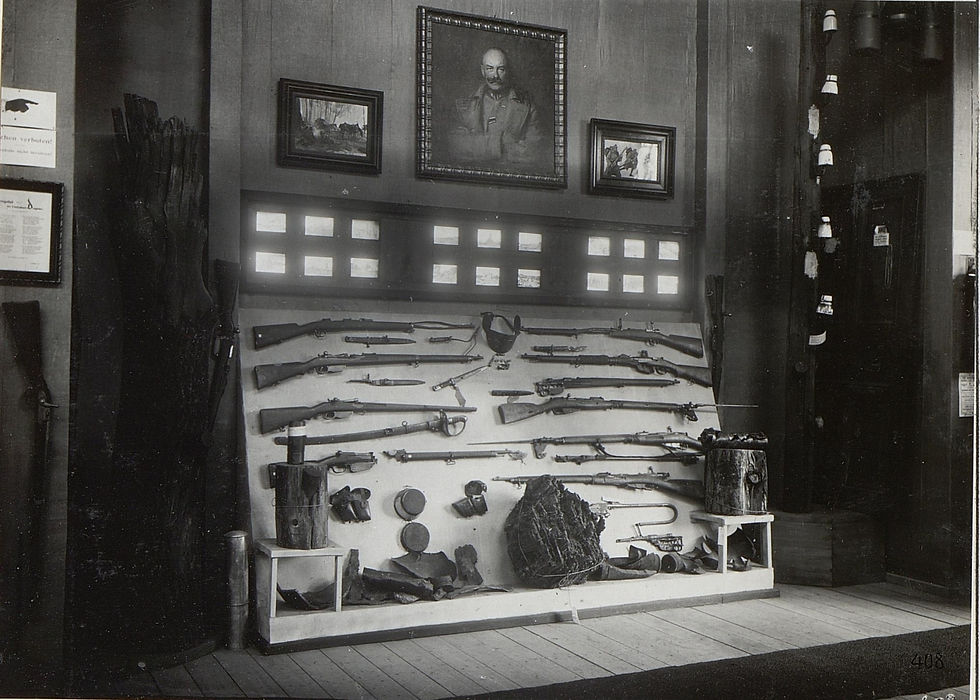
By late 1914, the Austro-Hungarian empire had already amassed thousands of captured M91 Russian Mosin-Nagant rifles, and began the work of converting them to fire the Austro-Hungarian M93 8x50R cartridge. There were two types of conversions done (this rifle is a Type 1 conversion):
Type 1 Conversion:
Lengthen the chamber throat to accept the longer 8x50R projectile. This was necessary because an 8x50R cartridge cannot fully chamber in a standard Mosin-Nagant
Re-cut the rifling to accept the wider 8x50R projectile. This was around a 0.323" projectile, vs ~0.310" for a 7.62x54R projectile
Type 2 Conversion:
Only the chamber was adjusted, the rifling was not modified. The Type 2 conversion is also referred to as the "Squeezebore" conversion
The conversion was done at several locations:
OEWG Steyr
Barendorf Arsenal


The easiest way to identify one of these conversions is by looking at the sight base. The sight graduations were renumbered to the Austrian "Schritt" measurement, with the numbers "6 5 4 3 2". These numbers were inlaid with a gold paint

It is not known exactly how many of these conversions were done, but it is currently estimated between 200,000 to 300,000 rifles were converted between 1915 and 1918. Most of these were M91 rifles, but some Dragoon and Cossack rifles were converted as well. After the Great War had ended and the Austro-Hungarian empire split apart, these rifles ended up in the hands of various new countries, such as Austria, Poland, Hungary, and Czechoslovakia. In the 1920s and 1930s, Finland purchased most of these already antiquated rifles, where they were either scrapped for parts, or re-barreled back to 7.62x54r. It is rumored that the chambers of some of these squeezebores were converted back to 7.62x54r, but more research is required in this area. Only a handful of these rifles still exist today in 8x50r, with a few more still waiting to be discovered in someone's attic in Europe

1st Sokol Battalion of Czechoslovakia during 1919
Translated using ChatGPT on 2/2/2015
Addressed to Miss Anna in Balice
"I. Sokolský prapor
Dear Anna,
I am writing to you from our station. We are well, and I hope the same for you. We have been marching a lot, but morale is high. Perhaps I will be able to visit soon. Please write back when you can.
With regards,
[Name unclear]"
Austro-Hungarian soldiers of Guardhouse 13
Notice the M91 at the far left of the picture. M91 bayonets can also be see on the soldier's belts
Ambulances in Kivivaara are put in an air shelter
Notice this soldier has an early M91 stock with a finger rest, as well as an Austro-Hungarian rear sling swivel at the 6 o'clock position
Finnish security guard at the border in Kivivaara
Notice this soldier has an M91 with an Austro-Hungarian stock. It has the rear sling swivel on the bottom of the stock at the 6 o'clock position
Montenegrin soldiers from Colorado
The Minute Men of Montenegro. This group of Montenegrin soldiers, who returned from their jobs in the Colorado mines to help their motherland in the war, came to meet Lieut. Col. Robert E. Olds, American Red Cross Commissioner to Europe, on his recent tour of the Balkan countries. They are the best fighters in the Montenegrin army and go about armed to the teeth rifles, hand grenades, knives and pistols being a part of their equipment. After the armistice these men formed a "Minute Man" Company to resist any attempt of another country to gain control of Montenegro. They also volunteered to act as guards for Red Cross Relief supplies. Note the soldier in the rear, second from the right, has a M91 rifle on his back. These soldiers are likely from the coal mining region of Las Animas county (Southern Colorado)
Austro-Hungarian cavern guard with M91 rifle
Primolano (just north of Monte Grappa). Entrance to the roadblock cavern.
Russian POWs working in the Dolomites
Russians working on cable car construction on the Obslauserriegel (Passo Ombretta) in the Italian Dolomites. Notice the Austro-Hungarian soldier, 3rd from the right, has an M91 rifle and a metal Mosin bayonet scabbard on his belt. Mosins even found their way to Italy during WW1
Austro-Hungarian roadblock at the Italian front
Roadblock KERSCHOWEC against FLITSCH. Taken on July 4, 1916. Isonzo front
Montenegrin Guerillas with captured Austro-Hungarian equipment
Loaded for stray Austrians. The Comitage of Montenegro were the scourge of the invading Austrian forces. For two years they waged a relentless guerilla warfare on the enemy. This shows a group of the hillmen wearing uniforms and carrying equipment they captured. Many of them are now under treatment for old wounds at the American Red Cross Hospital in Montenegro - 1919
Austro-Hungarian War Museum with Mosin wire cutters
Notice the two M91 rifles with captured wire cutter attachments
Austro-Hungarian soldier poses with his M91 rifle
This photograph features an M91 with an early pattern stock with no escutcheons
















